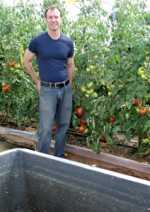Dry-Land Greenhouse

To understand how Paul Cross became, as he terms it, a “dry-land greenhouse” grower, you have to realize he didn’t set out to become a grower at all. A computer scientist, Cross helped bring the Internet to Taos, NM, a town known for its art community and posh resorts. But in the late ‘90s, Cross got caught when the spigot was cut off on the torrent of venture capital flowing into Internet-related businesses, “the dot-bomb phenomenon,” he says.
By then, however, Cross had already done rather well. He purchased 5 acres in the mountains north of Taos not to farm, but for the pretty views. But what now? “I’d gotten fried out on technology, and I didn’t need to work, but I had to do something,” he says. “Then I thought about how I’d always had a childhood love of growing things.”
With such tough growing conditions (See sidebar, “Location…”), Cross decided to build a greenhouse. That would protect his plants from the harsh environment, but he still needed to irrigate. For his home supply of water, he had a well — which had to be drilled 935 feet deep — that he shared with three other residences. He could have dug another well for the greenhouse, but the idea of creating a catch-water system to utilize rainwater and snow-melt appealed to him. “Groundwater supplies will get even shorter in the future, and all farmers in the West will need to look at water-saving strategies,” he says. “The rain will always fall. It might be less in some years, but it does come.”
Summer Rains
Cross soon learned that there was one very advantageous aspect to his location. Though like many other parts of the arid West, the region gets only about 12 inches of rain per year, but unlike most of those areas, much of that rain comes in the summer. Rainwater is a lot easier to catch than snow, says Cross, because a lot of the snow simply slides past the greenhouse gutters.
Cross also learned that for every 1,000 square feet of hardscape (rooftops, etc.), each inch of rain means 600 gallons of runoff. Between his house and greenhouse, Cross has 6,000 square feet of hardscape, but he’d like more. “Once you start catching rainwater, you start thinking about ways to catch more,” he says.
To store the water, Cross elected to go with cisterns. Some people choose ponds because they are cheaper, but the water in ponds readily evaporates in a dry climate, and he didn’t want to waste a drop. For cisterns, Cross recommends that growers budget about 50¢ per gallon of storage capability.
One cistern would have been too risky, because if there was a leak he could lose all of his water. Cross hired a welder to fabricate three cisterns, each 5 by 5 by 10 feet. One cistern is used for collecting water, another for warming it because the water is too cold to be used directly, and the third is where the fertilizers are added. Some water must be stored inside the greenhouse because it would freeze if stored outside in the winter, but Cross didn’t want to lose any precious growing space, so he buried the cisterns 3 feet below ground, 2 feet above ground. That way the tops of the tanks, which are flat, could be used for vegetable transplant production.
Use Gravity
The most important thing to remember with a catch-water system is that growers should use gravity as much as possible. Cross says that where he farms it seems like half the time it rains the power goes out, leaving him unable to run his electric pumps. It’s also important for new greenhouse growers to realize that rainwater is not the same as distilled water. It picks up small amounts of nitrogen and other things in the atmosphere, however, it has nowhere near the minerals of most water growers are used to using.
One final issue for growers who farm organically, like Cross, is that they have to realize they are going to face issues conventional growers will not. First, they will face far more emitter problems. A lot of organic fertilizers aren’t completely water soluble, so emitters will clog.
Also, if there’s a phosphorus deficiency, for instance, Cross can’t just give his plants a shot of phosphorus. Because of that, Cross gets yields of only about half of what a conventional greenhouse grower gets.
Not that Cross is complaining. “If I grow a tomato, I can sell it because I have no competition if you want a top-quality organic tomato,” he says. “At farmers’ markets, people line up 25 deep to get my tomatoes.”









